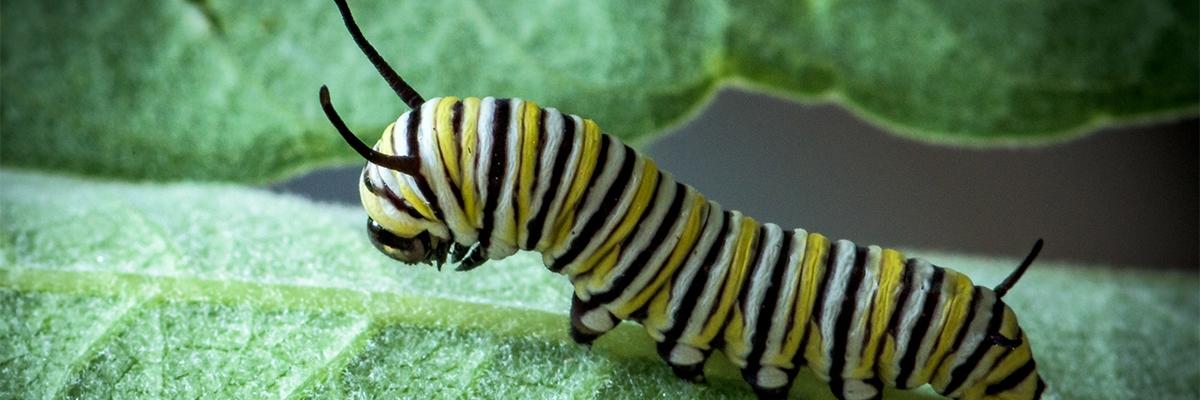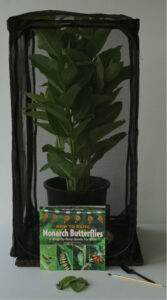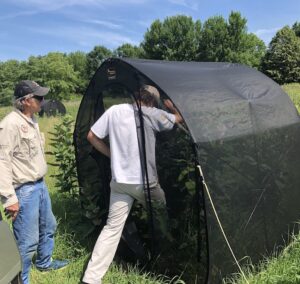Monarchs

Information
Autonomous Rearing of Monarchs in a BioTent
News Articles
“Everyone can help save the monarch butterfly” by Orlan Love
Our Objective
Our objective is to develop Monarch Zones (MZs) in homes, cities, and counties that are committed to our goal of repopulating the butterfly population. We will provide the foundation for you, and you in turn can help others. We want you to educate and encourage neighbors, family and friends.
Monarch zones are located in parks, schools, homes, businesses, wherever people live and work. The zone owners have the following goals:
- Raise and release monarchs with a natural rearing protocol using a BioTent™ or Outdoor Lifecycle Kit
- Add significant habitat; gardens and prairies rich in native forbs, milkweed, and grasses.
- Educate themselves and others by taking full advantage of the Monarch Research staff and materials.
- Measure, assess, and report results to the Monarch Research Station
About the Monarch Lifecycle Kit
 With Monarch Research’s Monarch Lifecycle Kit, you can now experience the joy of rearing Monarch butterflies on your porch, patio, balcony or deck. Observing a Monarch butterfly as it transforms itself from caterpillar to chrysalis to butterfly is truly awe-inspiring and a fantastic educational opportunity for kids of all ages.
With Monarch Research’s Monarch Lifecycle Kit, you can now experience the joy of rearing Monarch butterflies on your porch, patio, balcony or deck. Observing a Monarch butterfly as it transforms itself from caterpillar to chrysalis to butterfly is truly awe-inspiring and a fantastic educational opportunity for kids of all ages.
When you purchase a Lifecycle Kit, you will receive everything you need to successfully rear Monarch butterflies following a simple, natural rearing protocol.
Your kit includes:
- Heavy-duty 15″ x 15″ x 30″ Monarch Lifecycle enclosure
- 1 container of established milkweed
- 2-4 Monarch caterpillars
- Carol Pasternak’s book, “How to Raise Monarch Butterflies”
- 10″ saucer to keep milkweed moist
- Small paint brush & spoon to safely transfer your Monarch caterpillars onto the milkweed plant
Monarch Lifecycle Kit Resources
About the Monarch BioTent
A protected environment is essential to the successful rearing of monarch butterflies. Predation is the single largest factor in caterpillar mortality. Rates of survival will grow from less than 5% in the wild to over 80% in a protected enclosure. We have been fine-tuning the process so that you will be as successful as possible in raising butterflies
The Monarch Research team has spent considerable time over the past four years developing a rearing tent specifically for the monarch. The Monarch BiotTent™ is a super screen mesh tent, with a heavy zipper door, providing consistent airflow and temperature control while allowing rain flow for plants. We’ve tested this structure with milkweed, nectar plants, monarch butterfly eggs, caterpillars and paired mating monarchs with great success.

Cam and Jabe checking stock in a 6×6 BioTent.
The BioTent comes in two sizes: 6×6 and a 9×9. These tents are sold exclusively through Monarch Research and are available for pick up at the Monarch Research Station in Marion, Iowa.
For buyers outside of the area, shipping can be arranged at buyer’s expense. Shipping costs vary depending on location and we do our best to find the most economical shipping methods. Please email us to coordinate shipping.
BioTent Resources
- Order a BioTent
- Autonomous Monarch Rearing Recorded Webinar
- How to Fold BioTent (Video)
- BioQuip’s Monarch Capture Nets and Cages
- Capturing Monarchs in the Wild – Map to local prairies, parks & trails (Please do not attempt to capture Monarchs at locations marked as “Preserve”). Linn County Map
Resources
Mr. Lund Science
Mr. Lund Science offers a series of videos on monarch care and rearing:
- Mr. Lund Science: Raising Monarchs Part 3 – Caring For Caterpillars (How To Raise Caterpillars)
- Mr. Lund Science: Raising Monarchs Part 4 – The Chrysalis (How To Care For Monarch Butterfly Chrysalides)
- Mr. Lund Science: Raising Monarchs Part 5 – Releasing Adults (How To Raise Monarch Butterflies)
HOMEOWNERS: HOW-TO GUIDES FOR ESTABLISHING POLLINATOR GARDENS
Homeowners with all sizes of land can contribute to pollination efforts. Establishing Pollinator Meadows from Seed is a 12-page guide created by The Xerces Society providing step by step instruction and helpful hints on creating pollinator habitat on your property.
Project Pollinator: Building Gardens for Pollinators: A Comprehensive “How-to” Guide was produced by the US Fish & Wildlife Services. You’ll find straight forward how-to’s and facts pertaining to pollinator and good gardens, as well as a wealth of additional resources and links at the end of this guide.
The Xerces Society publishes regional planting guides for Monarch nectar plants. Check out this comprehensive list of nectar plants native or adapted to the Midwest: Midwest Monarch Nectar Plants.
The Monarch Joint Venture (MJV) is a partnership of federal and state agencies, non-governmental organizations, and academic programs that are working together to support and coordinate efforts to protect the monarch migration across the lower 48 United States. On their website you’ll find information on Monarch life cycle, threats, and migration, as well as tangible guides on how to Create Habitat for Monarchs.
